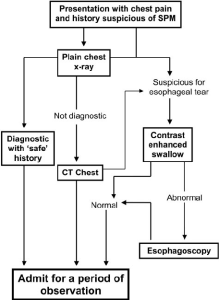Your patient is a 24 yo M with chest pain. It is pleuritic. He has normal vitals and you’re not too concerned. You get a CXR and you see the result in this post. He has pneumomediastinum! What is that? What do I Do now?
Spontaneous pneumomediastinum is rare, occurring in approximately 1 in 30,000 patients presenting to the ED. It typically presents with subcutaneous emphysema (MCC), sudden onset pleuritic chest pain, and dyspnea. Also, patients can develop neck pain, neck swelling, and hoarse voice. The heart exam may reveal a characteristic crunching sound that is synchronous with systole (Hamman’s sign)
Causative mechanisms:
It is most commonly described as resulting from positive pressure ventilation OR as a spontaneous occurrence caused by increased intrathoracic pressure. Esophageal perforation can lead to pneumomediastinum and subcutaneous emphysema, as can occur in Boerhaave’s syndrome. Rib fracture, neck trauma, and chest tube insertion have also been implicated in introducing air to the subcutaneous tissues through the respiratory tract. Infection with gas-forming organisms can also cause pneumomediastinum, but this is associated with mediastinitis. Air can also be introduced via the intra-abdominal or retroperitoneal gastrointestinal tract, as well. If air extends along the fascial planes of the submandibular and retropharyngeal spaces through the neural foramina into the epidural space, pneumoracchis (air within the spinal canal) can result.
Identify the source:
CT imaging (CT neck and CT chest with IV contrast), Bronchoscopy, EGD and esophagrams can be useful. An algorithm for the diagnosis and management of spontaneous pneumomediastinum from CHEST 2005 is available to help with difficult
Clinical Significance:
The clinical significance of subcutaneous emphysema ranges from benign to life threatening. The primary treatment is to treat the underlying cause. The symptoms often resolve within 1 week with oxygen therapy, reassurance, and analgesics. The majority of spontaneous subcutaneous emphysema cases resolve with conservative treatment, and certain cases may not even warrant admission to thehospital. Of note, subcutaneous emphysema with pneumomediastinum can occasionally lead to tension physiology is a life-threatening event that benefits from rapid decompression.

